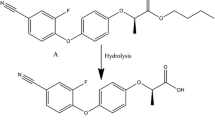Abstract
The dissipation and residue of pymetrozine in rice field ecosystem were studied based on a novel and reliable analytical method for pymetrozine in paddy water, soil, rice straw, brown rice, and rice husk. The pymetrozine residues were extracted with acetonitrile and cleaned up by Carb-NH2 SPE cartridge and determined by high-performance liquid chromatography electrospray ionization tandem mass spectrometry (LC-ESI-MS-MS). The dissipation of pymetrozine followed first-order kinetics and its half-lives ranged from 1.7 to 1.8 days in paddy water, 5.1 to 5.7 days in soil, and 2.3 to 2.6 days in rice straw, respectively. At harvest time, the highest final residues of pymetrozine varied in soil among three geographical fields and were below the limit of detection in rice tissues. The recommended dosage was considered to be safe for human beings and animals, and the results were helpful in setting maximum residue limit for pymetrozine in rice.


Similar content being viewed by others
References
Abd Al-Rahman, S. H., Almaz, M. M., & Ahmed, N. S. (2012). Dissipation of fungicides, insecticides, and acaricide in tomato using HPLC-DAD and QuEChERS Methodology. Food Analytical Methods, 5, 564–570.
Bhanti, M., & Taneja, A. (2007). Contamination of vegetables of different seasons with organophosphorous pesticides and related health risk assessment in northern India. Chemosphere, 69, 63–68.
EPA (2000). United States Environmental Protection Agency. http://www.epa.gov/pesticides/chem_search/reg_actions/registration/fs_PC-101103_01-Aug-00.pdf Issued August 2000.
Guan, W. B., Li, Z. N., Zhang, H. Y., Hong, H. J., Rebeyev, N., Ye, Y., & Ma, Y. Q. (2013). Amine modified graphene as reversed-dispersive solid phase extraction materials combined with liquid chromatography-tandem mass spectrometry for pesticide multi-residue analysis in oil crops. Journal of Chromatography A, 1286, 1–8.
Hong, J. H., Lee, C. R., Lim, J. S., & Lee, K. S. (2011). Comparison of analytical methods and residue patterns of pymetrozine in Aster scaber. Bulletin of Environmental Contamination and Toxicology, 87, 649–652.
Lashkari, M. R., Sahragard, A., & Ghadamyari, M. (2007). Sublethal effects of imidacloprid and pymetrozine on growth parameters of cabbage aphid, Brevicoryne brassicae on rapeseed, Brassica napus L. Insect Sci., 14, 207–212.
Lee, S. W., Choi, J. H., Cho, S. K., et al. (2011). Development of a new QuEChERS method based on dry ice for the determination of 168 pesticides in paprika using tandem mass spectrometry. Journal of Chromatography A, 1218, 4366–4377.
Lehotay, S. J., Son, K. A., Kwon, H., Koesukwiwat, U., Fu, W. S., Mastovska, K., et al. (2010). Comparison of QuEChERS sample preparation methods for the analysis of pesticide residues in fruits and vegetables. Journal of Chromatography A, 1217, 2548–2560.
Li, C., Yang, T., Huangfu, W. G., & Wang, Y. L. (2011). Residue and dynamics of pymetrozine in rice field ecosystem. Chemosphere, 82, 901–904.
Mercan, H., Yilmaz, E., & Inam, R. (2007). Determination of insecticide pymetrozine by differential pulse polarography/application to lake water and orange juice. Journal of Hazardous Materials, 141, 700–706.
Shen, G. Q., Hu, X., & Hu, Y. (2009). Kinetic study of the degradation of the insecticide pymetrozine in a vegetable-field ecosystem. Journal of Hazardous Materials, 164, 497–501.
Yi, X., & Lu, Y. T. (2006). Residues and dynamics of probenazole in rice field ecosystem. Chemosphere, 65, 639–643.
Zhang, X., Cheng, X., Wang, C., Xi, Z., & Li, Q. (2007). Efficient high-performance liquid chromatography with liquid-liquid partition cleanup method for the determination of pymetrozine in tobacco. Annali di Chimica, 97, 295–301.
Zhang, C. Z., Zhang, Z. Y., Liu, X. J., Jiang, W., & Wu, Y. D. (2010). Dissipation and environmental fate of herbicide H-9201 in carrot plantings under field conditions. Food Chemistry, 119, 874–879.
Acknowledgments
This work was supported by grants from the Institute for the Control of Agrochemicals, Ministry of Agriculture of the People’s Republic of China.
Author information
Authors and Affiliations
Corresponding author
Rights and permissions
About this article
Cite this article
Zhang, Y., Zhang, L., Xu, P. et al. Dissipation and residue of pymetrozine in rice field ecosystem. Environ Monit Assess 187, 78 (2015). https://doi.org/10.1007/s10661-014-4256-x
Received:
Accepted:
Published:
DOI: https://doi.org/10.1007/s10661-014-4256-x




